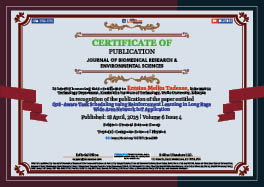Ermias Melku Tadesse*, Haimanot Edmealem, Tesfaye Belay and Abubeker Girma
Volume6-Issue4
Dates: Received: 2025-03-13 | Accepted: 2025-04-15 | Published: 2025-04-18
Pages: 340-360
Abstract
Objective: The primary objective of this study is to develop a QoS-aware task scheduling algorithm for LoRaWAN IoT applications using a Reinforcement Learning (RL) approach.
Introduction: LoRaWAN is a widely adopted Low Power Wide Area Network (LPWAN) protocol designed for Internet of Things (IoT) applications due to its long-range communication and low power consumption. However, ensuring QoS in LoRaWAN networks remains challenging due to limited bandwidth, high device density, and dynamic traffic patterns. Existing scheduling algorithms often fail to balance competing QoS requirements effectively. Reinforcement Learning (RL) offers a promising solution by enabling intelligent decision-making through interaction with the network environment.
Case representation: The proposed model employs a Deep Q-Network (DQN) to optimize task scheduling in LoRaWAN networks. The RL agent interacts with a simulated LoRaWAN environment built using NS-3, where it learns to make scheduling decisions based on real-time network states. Key parameters, such as delay, PDR, PER, and throughput, are used as inputs to the reward function to guide the learning process. Performance is evaluated against existing models like RT-LoRa, and LoRa+ under varying node densities and traffic scenarios.
Result: The simulation results demonstrate that the proposed RL-based task scheduling algorithm outperforms existing models across multiple Quality of Service (QoS) metrics. It achieves the lowest delay at approximately 40 ms, significantly outperforming RT-LoRa, which has a delay of around 120 ms, and LoRa+, which experiences a delay of about 80ms. In terms of Packet Delivery Ratio (PDR), the model maintains a competitive value of approximately 85%, comparable to LoRa+ at 87%. Additionally, it records the lowest Packet Error Rate (PER) at around 5%, outperforming RT-LoRa and LoRa+, which exhibit PER values of approximately 15% and 10%, respectively. Furthermore, the model achieves the highest throughput of approximately 250 kbps, surpassing RT-LoRa at 150 kbps and LoRa+ at 200 kbps, demonstrating its superior performance in optimizing network efficiency.
Discussion: The proposed model demonstrates significant strengths in reducing delay and PER while maximizing throughput, making it suitable for time-sensitive IoT applications. However, its marginal improvement in PDR compared to existing models highlights an area for further optimization. Additionally, energy efficiency was not explicitly addressed in this study, which is critical for LPWAN applications like LoRaWAN. These limitations suggest potential directions for future research.
Conclusion: This research successfully develops a QoS-aware task scheduling algorithm using reinforcement learning for LoRaWAN IoT applications. By dynamically adapting to network conditions, the proposed model achieves superior performance across multiple QoS metrics compared to state-of-the-art algorithms. Future work will focus on incorporating energy efficiency into the model and extending its applicability to multi-gateway scenarios.
FullText HTML
FullText PDF
DOI: 10.37871/jbres2089
Certificate of Publication

Copyright
© 2025 Tadesse EM, et al. Distributed under Creative Commons CC-BY 4.0
How to cite this article
Tadesse EM, Edmealem H, Belay T, Girma A. QoS-Aware Task Scheduling using Reinforcement Learning in Long Rage Wide Area Network IoT Application. J Biomed Res Environ Sci. 2025 Apr 18; 6(4): 340-360. doi: 10.37871/jbres2089, Article ID: JBRES2089, Available at: https://www.jelsciences.com/articles/jbres2089.pdf
Subject area(s)
References
- Mahmood NH, Marchenko N, Gidlund M, Popovski P. Wireless networks and industrial IoT: Applications, challenges and enablers. 2020. doi: 10.1007/978-3-030-51473-0.
- de Oliveira LR, de Moraes P, Neto LPS, da Conceição AF. Review of LoRaWAN applications. 2020. doi: 10.48550/arXiv.2004.05871.
- Marais JM, Malekian R, Abu-Mahfouz AM. LoRa and LoRaWAN testbeds: A review. IEEE AFRICON Sci. Technol Innov Africa AFRICON. 2017;1496-1501. doi: 10.1109/AFRCON.2017.8095703.
- K. Mekki, E. Bajic, F. Chaxel, F. Meyer. Overview of cellular LPWAN technologies for IoT deployment: Sigfox, LoRaWAN, and NB-IoT,” 2018 IEEE Int. Conf. Pervasive Comput. Commun. Work. PerCom Work. 2018;197-202. doi: 10.1109/PERCOMW.2018.8480255.
- Bouguera T, Diouris JF, Chaillout JJ, Jaouadi R, Andrieux G. Energy consumption model for sensor nodes based on LoRa and LoRaWAN. Sensors (Switzerland). 2018;18(7):1-23. doi: 10.3390/s18072104.
- Augustin A, Yi J, Clausen T, Townsley WM. A Study of LoRa: Long Range & Low Power Networks for the Internet of Things. Sensors (Basel). 2016 Sep 9;16(9):1466. doi: 10.3390/s16091466. PMID: 27618064; PMCID: PMC5038744.
- Ragnoli M, Barile G, Leoni A, Ferri G, Stornelli V. An autonomous low-power lora-based flood-monitoring system. J Low Power Electron Appl. 2020;10:2. doi: 10.3390/jlpea10020015.
- Haxhibeqiri J, Moerman I, Hoebeke J. Low overhead scheduling of LoRa transmissions for improved scalability. IEEE Internet Things J. 2019;6(2)3:097-3109. doi: 10.1109/JIOT.2018.2878942.
- Sutton RS, Barto AG. Reinforcement learning_Peter. Learning. 2012;3:9.
- Petäjäjärvi J, Mikhaylov K, Pettissalo M, Janhunen J, Iinatti J. Performance of a low-power wide-area network based on lora technology: Doppler robustness, scalability, and coverage. Int J Distrib Sens Networks. 2017;13:3. doi: 10.1177/1550147717699412.
- Polonelli T, Brunelli D, Marzocchi A, Benini L. Slotted ALOHA on LoRaWAN-Design, Analysis, and Deployment. Sensors (Basel). 2019 Feb 18;19(4):838. doi: 10.3390/s19040838. PMID: 30781662; PMCID: PMC6413417.
- Alenezi M, Chai KK, Alam AS, Chen Y, Jimaa S. Unsupervised learning clustering and dynamic transmission scheduling for efficient dense LoRaWAN networks. IEEE Access. 2020;8:191495-191509. doi: 10.1109/ACCESS.2020.3031974.
- Leonardi L, Battaglia F, Lo Bello L. RT-LoRa: A medium access strategy to support real-time flows over LoRa-based networks for industrial IoT applications. IEEE Internet Things J. 2019;6(6):10812-10823. doi: 10.1109/JIOT.2019.2942776.
- Sallum E, Pereira N, Alves M, Santos M. Improving quality-of-service in LOra low-power wide-area networks through optimized radio resource management. J Sens Actuator Networks. 2020;9(1)1-26. doi: 10.3390/jsan9010010.
- Micheletto M, Zabala P, Ochoa SF, Meseguer R, Santos R. Determining Real-Time Communication Feasibility in IoT Systems Supported by LoRaWAN. Sensors (Basel). 2023 Apr 26;23(9):4281. doi: 10.3390/s23094281. PMID: 37177485; PMCID: PMC10181743.
- Garrido-Hidalgo C, Haxhibeqiri J, Moons B, Hoebeke J, Olivares T, Ramirez FJ. LoRaWAN scheduling: From concept to implementation. IEEE Internet Things J. 2021;8(16):12919-12933. doi: 10.1109/JIOT.2021.3064430.
- Siddiqi UF, Sait SM, Uysal M. Deep reinforcement based power allocation for the max-min optimization in non-orthogonal multiple access. IEEE Access. 2020;8:211235-211247. doi: 10.1109/ACCESS.2020.3038923.






























































